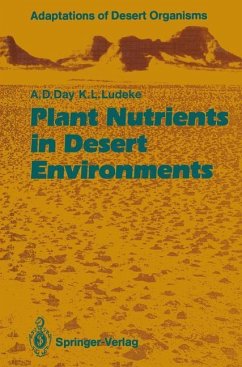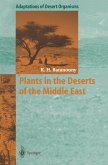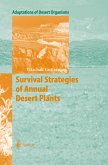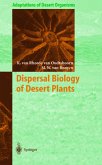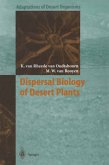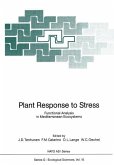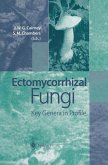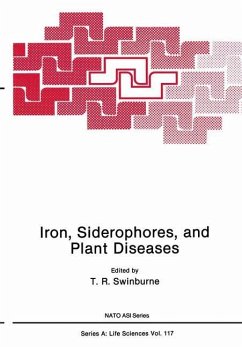- Broschiertes Buch
- Merkliste
- Auf die Merkliste
- Bewerten Bewerten
- Teilen
- Produkt teilen
- Produkterinnerung
- Produkterinnerung
Plant nutrients are found in a relatively thin layer of soil materials that covers all of the continents of the entire world. These plant nutrients provide the necessary food, clothing, and shelter for human existence. As the population of the world increases, the plant nutrients in desert environments become more and more important for the survival of mankind. Plant Nutrients in Desert Environments is a general information book for both professionals and laymen. The common plant nutrients present in deserts are identified, and detailed instructions are given on how to effectively utilize them…mehr
Andere Kunden interessierten sich auch für
![Plants in the Deserts of the Middle East Plants in the Deserts of the Middle East]() Kamal H. BatanounyPlants in the Deserts of the Middle East153,99 €
Kamal H. BatanounyPlants in the Deserts of the Middle East153,99 €![Survival Strategies of Annual Desert Plants Survival Strategies of Annual Desert Plants]() Yitzchak GuttermanSurvival Strategies of Annual Desert Plants115,99 €
Yitzchak GuttermanSurvival Strategies of Annual Desert Plants115,99 €![Dispersal Biology of Desert Plants Dispersal Biology of Desert Plants]() Karen van Rheede van OudtshoornDispersal Biology of Desert Plants168,99 €
Karen van Rheede van OudtshoornDispersal Biology of Desert Plants168,99 €![Dispersal Biology of Desert Plants Dispersal Biology of Desert Plants]() Karen van Rheede van OudtshoornDispersal Biology of Desert Plants164,99 €
Karen van Rheede van OudtshoornDispersal Biology of Desert Plants164,99 €![Plant Response to Stress Plant Response to Stress]() Plant Response to Stress115,99 €
Plant Response to Stress115,99 €![Ectomycorrhizal Fungi Ectomycorrhizal Fungi]() Ectomycorrhizal Fungi223,99 €
Ectomycorrhizal Fungi223,99 €![Iron, Siderophores, and Plant Diseases Iron, Siderophores, and Plant Diseases]() T. R. SwinburneIron, Siderophores, and Plant Diseases39,99 €
T. R. SwinburneIron, Siderophores, and Plant Diseases39,99 €-
-
-
Plant nutrients are found in a relatively thin layer of soil materials that covers all of the continents of the entire world. These plant nutrients provide the necessary food, clothing, and shelter for human existence. As the population of the world increases, the plant nutrients in desert environments become more and more important for the survival of mankind. Plant Nutrients in Desert Environments is a general information book for both professionals and laymen. The common plant nutrients present in deserts are identified, and detailed instructions are given on how to effectively utilize them in commercial agriculture, home gardening, home landscaping, for disturbed land reclamation and for recreational purposes. Outstanding photographs illustrate the topics.
Hinweis: Dieser Artikel kann nur an eine deutsche Lieferadresse ausgeliefert werden.
Hinweis: Dieser Artikel kann nur an eine deutsche Lieferadresse ausgeliefert werden.
Produktdetails
- Produktdetails
- Adaptations of Desert Organisms
- Verlag: Springer / Springer Berlin Heidelberg / Springer, Berlin
- Artikelnr. des Verlages: 978-3-642-77654-0
- Softcover reprint of the original 1st ed. 1993
- Seitenzahl: 132
- Erscheinungstermin: 6. Dezember 2011
- Englisch
- Abmessung: 235mm x 155mm x 8mm
- Gewicht: 213g
- ISBN-13: 9783642776540
- ISBN-10: 364277654X
- Artikelnr.: 36118441
- Herstellerkennzeichnung
- Springer-Verlag GmbH
- Tiergartenstr. 17
- 69121 Heidelberg
- ProductSafety@springernature.com
- Adaptations of Desert Organisms
- Verlag: Springer / Springer Berlin Heidelberg / Springer, Berlin
- Artikelnr. des Verlages: 978-3-642-77654-0
- Softcover reprint of the original 1st ed. 1993
- Seitenzahl: 132
- Erscheinungstermin: 6. Dezember 2011
- Englisch
- Abmessung: 235mm x 155mm x 8mm
- Gewicht: 213g
- ISBN-13: 9783642776540
- ISBN-10: 364277654X
- Artikelnr.: 36118441
- Herstellerkennzeichnung
- Springer-Verlag GmbH
- Tiergartenstr. 17
- 69121 Heidelberg
- ProductSafety@springernature.com
1 Introduction.- 2 Plant Nutrients.- 2.1 Essential Plant Nutrient Elements.- 2.2 Effects of Plant Nutrient Elements on Plants.- 3 Soil Materials.- 4 Organic Soil Materials.- 4.1 Functions.- 4.2 Composition.- 4.3 Sources.- 4.4 Management.- 4.5 Maintenance.- 5 Soil Moisture.- 5.1 Field Capacity.- 5.2 Permanent-Wilting Percentage.- 5.3 Movement of Water.- 6 Soil Aeration.- 6.1 Composition of Soil Air.- 6.2 Soil Aeration and Plant Growth.- 7 Exchangeable Bases.- 7.1 Exchangeable Bases and Plant Nutrition.- 8 Soil Acidity.- 9 Soil Alkalinity.- 10 Nitrogen as a Plant Nutrient.- 10.1 Nitrogen in Soils.- 10.2 Nitrogen in Plants.- 10.3 Forms of Nitrogen Utilized by Plants.- 11 Phosphorus as a Plant Nutrient.- 11.1 Phosphorus in Soils.- 11.2 Phosphorus in Plants.- 11.3 Forms of Phosphorus Utilized by Plants.- 12 Potassium as a Plant Nutrient.- 12.1 Potassium in Soils.- 12.2 Potassium in Plants.- 13 Plant Nutrients in Desert Soils.- 13.1 Soils in the Yuma Subdesert.- 13.2 Man's Invasion.- 13.3 How Desert Soils Differ.- 13.4 Minerals in Soils.- 14 Soil Moisture in Desert Environments.- 14.1 Soil Moisture Quantity.- 14.2 Soil Moisture Quality.- 15 Plant Nutrients Required for Growth.- 15.1 Plant Nutrients.- 15.2 Essential Elements in Plant Nutrition.- 16 Plant Nutrients in Municipal Wastewater.- 16.1 Municipal Wastewater Treatment.- 16.2 Irrigation with Municipal Wastewater.- 16.3 Future Prospects.- 17 Plant Nutrients in Sewage Sludge.- 17.1 Sewage Sludge Treatment.- 17.2 Plant Growth Factors in Sewage Sludge.- 17.3 Fertilization with Dry Sewage Sludge.- 17.4 Fertilization with Liquid Sewage Sludge.- 17.5 Future Prospects.- 18 Plant Growth in Desert Environments.- 18.1 The Dry Regions of the World.- 18.2 Climatic Factors Affect Plant Growth.- 18.3 Soil Fertility and ItsMaintenance.- 18.4 Fertilizer Use in Dry Regions.- 18.5 Crop Introduction and Improvement.- 19 Urban Utilization of Plant Nutrients.- 19.1 Plants in the Living Environment to Lift the Spirits of Man.- 19.2 Home Gardens Reduce Food Costs, Landscape Homesteads, and Improve Neighborliness.- 19.3 City Parks, Golf Courses, and Recreation Areas.- 20 Plant Nutrients for Disturbed Land Reclamation.- 20.1 Classification of Disturbed Lands.- 20.2 Reclamation Purposes and Alternatives.- 20.3 Spoil Replacement and Revegetation Techniques.- 20.4 Coal Mine Reclamation in Desert Areas.- 20.5 Vegetation Adaptability.- 21 Desert Environments Offer an Outstanding Future Potential.- 21.1 Technology Unlocks Cropland Productivity.- 21.2 Future Agricultural Research.- 21.3 Gardening for Food and Fun.- 21.4 Living on a Few Acres.- 21.5 Desert Environments Attract People.- Glossary of Agronomic Terms.- References.- Figure Index.- Fig. 1. Commercial agriculture in the desert area in Colorado, USA.- Fig. 2. Mixed vegetables grown in a small farm garden.- Fig. 3. A sand dune complex at the foot of mountains in Sangre de Christo, Colorado, USA.- Fig. 4. Plowing under sorghum stubble with a seven- bottom moldboard plow.- Fig. 5. Furrow irrigation in Texas, USA.- Fig. 6. An earthworm and earthworm castings in a fertile organic soil.- Fig. 7. Orange trees in Florida, USA growing in a fertile sandy loam soil.- Fig. 8. Planting corn and applying commercial fertilizers and soil amendments in the USA.- Fig. 9. Alkaline soil deposits in a desert area in California, USA.- Fig. 10. A stunted ear of corn caused by an extreme soil nitrogen deficiency.- Fig. 11. Surface application of inorganic fertilizer in Arizona, USA.- Fig. 12. Potassium-deficient corn in the USA.- Fig. 13. Native vegetation in a desert area in Arizona, USA.- Fig. 14. The Rio Grande River in Texas, USA.- Fig. 15. Side-dressing corn with anhydrous ammonia nitrogen fertilizer in the USA.- Fig. 16. Beef cattle grazing on an irrigated pasture in a desert area in Colorado, USA.- Fig. 17. Injection of liquid municipal sewage sludge into agricultural soil in the USA.- Fig. 18. Young citrus trees growing in a desert area in Arizona, USA.- Fig. 19. An outstanding home in a desert area in California, USA.- Fig. 20. Copper mine tailings that have been contoured to prevent wind erosion in Arizona, USA.- Fig. 21. A irrigated family farm in a desert area in the southwestern USA.- Fig. 22. A modern city established in a desert environment in the southwestern USA.
1 Introduction.- 2 Plant Nutrients.- 2.1 Essential Plant Nutrient Elements.- 2.2 Effects of Plant Nutrient Elements on Plants.- 3 Soil Materials.- 4 Organic Soil Materials.- 4.1 Functions.- 4.2 Composition.- 4.3 Sources.- 4.4 Management.- 4.5 Maintenance.- 5 Soil Moisture.- 5.1 Field Capacity.- 5.2 Permanent-Wilting Percentage.- 5.3 Movement of Water.- 6 Soil Aeration.- 6.1 Composition of Soil Air.- 6.2 Soil Aeration and Plant Growth.- 7 Exchangeable Bases.- 7.1 Exchangeable Bases and Plant Nutrition.- 8 Soil Acidity.- 9 Soil Alkalinity.- 10 Nitrogen as a Plant Nutrient.- 10.1 Nitrogen in Soils.- 10.2 Nitrogen in Plants.- 10.3 Forms of Nitrogen Utilized by Plants.- 11 Phosphorus as a Plant Nutrient.- 11.1 Phosphorus in Soils.- 11.2 Phosphorus in Plants.- 11.3 Forms of Phosphorus Utilized by Plants.- 12 Potassium as a Plant Nutrient.- 12.1 Potassium in Soils.- 12.2 Potassium in Plants.- 13 Plant Nutrients in Desert Soils.- 13.1 Soils in the Yuma Subdesert.- 13.2 Man's Invasion.- 13.3 How Desert Soils Differ.- 13.4 Minerals in Soils.- 14 Soil Moisture in Desert Environments.- 14.1 Soil Moisture Quantity.- 14.2 Soil Moisture Quality.- 15 Plant Nutrients Required for Growth.- 15.1 Plant Nutrients.- 15.2 Essential Elements in Plant Nutrition.- 16 Plant Nutrients in Municipal Wastewater.- 16.1 Municipal Wastewater Treatment.- 16.2 Irrigation with Municipal Wastewater.- 16.3 Future Prospects.- 17 Plant Nutrients in Sewage Sludge.- 17.1 Sewage Sludge Treatment.- 17.2 Plant Growth Factors in Sewage Sludge.- 17.3 Fertilization with Dry Sewage Sludge.- 17.4 Fertilization with Liquid Sewage Sludge.- 17.5 Future Prospects.- 18 Plant Growth in Desert Environments.- 18.1 The Dry Regions of the World.- 18.2 Climatic Factors Affect Plant Growth.- 18.3 Soil Fertility and ItsMaintenance.- 18.4 Fertilizer Use in Dry Regions.- 18.5 Crop Introduction and Improvement.- 19 Urban Utilization of Plant Nutrients.- 19.1 Plants in the Living Environment to Lift the Spirits of Man.- 19.2 Home Gardens Reduce Food Costs, Landscape Homesteads, and Improve Neighborliness.- 19.3 City Parks, Golf Courses, and Recreation Areas.- 20 Plant Nutrients for Disturbed Land Reclamation.- 20.1 Classification of Disturbed Lands.- 20.2 Reclamation Purposes and Alternatives.- 20.3 Spoil Replacement and Revegetation Techniques.- 20.4 Coal Mine Reclamation in Desert Areas.- 20.5 Vegetation Adaptability.- 21 Desert Environments Offer an Outstanding Future Potential.- 21.1 Technology Unlocks Cropland Productivity.- 21.2 Future Agricultural Research.- 21.3 Gardening for Food and Fun.- 21.4 Living on a Few Acres.- 21.5 Desert Environments Attract People.- Glossary of Agronomic Terms.- References.- Figure Index.- Fig. 1. Commercial agriculture in the desert area in Colorado, USA.- Fig. 2. Mixed vegetables grown in a small farm garden.- Fig. 3. A sand dune complex at the foot of mountains in Sangre de Christo, Colorado, USA.- Fig. 4. Plowing under sorghum stubble with a seven- bottom moldboard plow.- Fig. 5. Furrow irrigation in Texas, USA.- Fig. 6. An earthworm and earthworm castings in a fertile organic soil.- Fig. 7. Orange trees in Florida, USA growing in a fertile sandy loam soil.- Fig. 8. Planting corn and applying commercial fertilizers and soil amendments in the USA.- Fig. 9. Alkaline soil deposits in a desert area in California, USA.- Fig. 10. A stunted ear of corn caused by an extreme soil nitrogen deficiency.- Fig. 11. Surface application of inorganic fertilizer in Arizona, USA.- Fig. 12. Potassium-deficient corn in the USA.- Fig. 13. Native vegetation in a desert area in Arizona, USA.- Fig. 14. The Rio Grande River in Texas, USA.- Fig. 15. Side-dressing corn with anhydrous ammonia nitrogen fertilizer in the USA.- Fig. 16. Beef cattle grazing on an irrigated pasture in a desert area in Colorado, USA.- Fig. 17. Injection of liquid municipal sewage sludge into agricultural soil in the USA.- Fig. 18. Young citrus trees growing in a desert area in Arizona, USA.- Fig. 19. An outstanding home in a desert area in California, USA.- Fig. 20. Copper mine tailings that have been contoured to prevent wind erosion in Arizona, USA.- Fig. 21. A irrigated family farm in a desert area in the southwestern USA.- Fig. 22. A modern city established in a desert environment in the southwestern USA.

